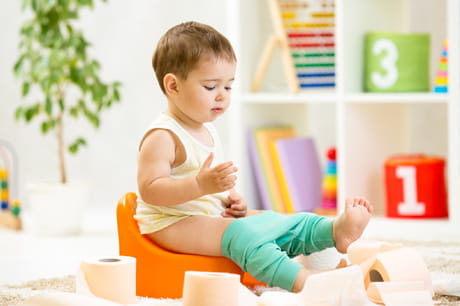How long is too long on the potty?
Patience is a virtue — hemorrhoids aren’t
The porcelain throne. For adults, it’s a no-brainer. But for kids, it’s a strange, new world.
Potty training is an important milestone for kids, but it can take some time for them to feel comfortable enough to do their business.
“Potty training is an exciting and confusing time for parents,” said Geisinger pediatrician Maria Alexies Samonte, MD. “No two kids are the same, so parents are often wondering how their child is doing, and if they’re training their child properly. One thing that’s important is monitoring how long children spend on the toilet. If they spend too much time, it can lead to health issues.”
What happens when you sit too long?
Spending too much time on the toilet causes pressure on your rectum and anus. Because the seat is cut out, your rectum is lower than the rest of your backside. Gravity takes over, and blood starts to pool and clot in those veins. Add in any straining or pushing, and you may have a recipe for hemorrhoids.
“Hemorrhoids, or piles, are essentially varicose veins in your rectum or anus,” said Dr. Samonte. “They form because of excess pressure on the veins. As a result, the veins can bulge and fill with blood clots. This can lead to pain, itching and other unpleasant effects. While hemorrhoids are less common in children, they still can happen. Plus, habits can last a lifetime—meaning they may get used to spending too much time in the bathroom, putting them at risk for hemorrhoids later in life.”
How long is too long?
Potty training is a balancing act. Making your child comfortable with sitting on the toilet takes time and practice.
Most professionals recommend spending no more time on the toilet than it takes to pass a stool. Studies have shown that the average bowel movement takes 12 seconds. Sometimes it does take longer, however, so at maximum, you should not spend more than 10 minutes on the toilet.
“If your child doesn’t go within the first few minutes, you’re better off to try again later,” said Dr. Samonte. “Bowel movements occur because of the movement of your intestines. If you don’t go to the bathroom immediately, the waste can travel back up into the colon. When this happens, you’re better off to wait until you feel the urge again rather than trying to push it out.”
Tips to avoid sitting too long
A good way to help regulate the amount of time kids spend on the toilet is by reading to them. Have at least three short books that are designated “potty books.” Reading stories can help children relax while they’re on the toilet, making it easier to have a bowel movement. If they don’t go by the time you’re finished with the book, have them come back and try later.
“The best time to bring kids to the bathroom is 15 to 30 minutes after eating,” said Dr. Samonte. “The body has a natural reflex after eating that should make having a bowel movement easier. If your child is struggling to have a bowel movement within 10 minutes, you should look at their diet. Are they getting enough fiber? Are they drinking enough water? If that’s still not enough, talk to you doctor.”
Maria Alexies Samonte, MD, is a pediatrician at Geisinger Mountain Top. To schedule an appointment, please call 800-275-6401 or visit Geisinger.org.

